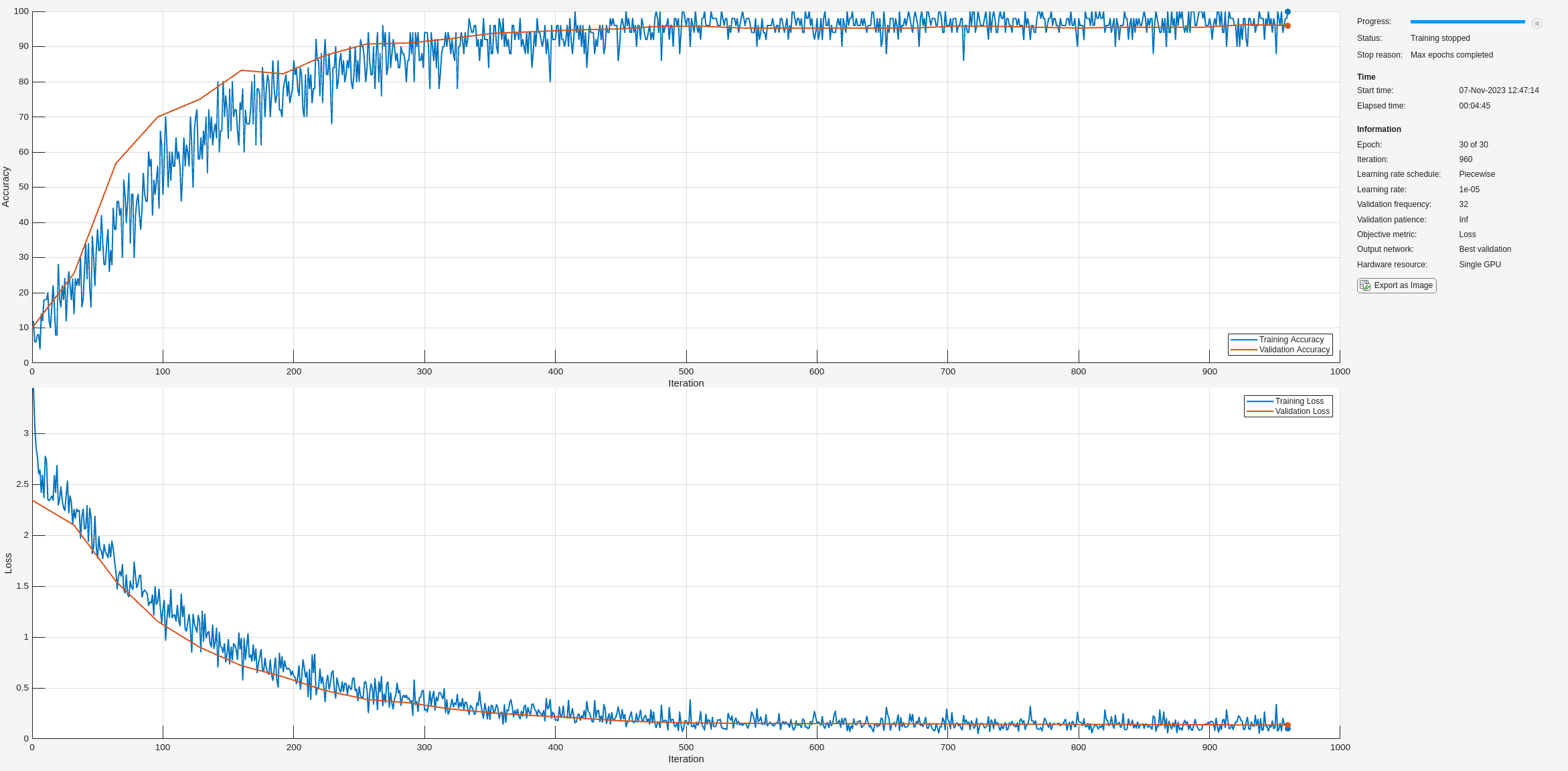Train Spoken Digit Recognition Network Using Out-of-Memory Features
This example trains a spoken digit recognition network on out-of-memory auditory spectrograms using a transformed datastore. In this example, you extract auditory spectrograms from audio using audioDatastore and audioFeatureExtractor, and you write them to disk. You then use a signalDatastore to access the features during training. The workflow is useful when the training features do not fit in memory. In this workflow, you only extract features once, which speeds up your workflow if you are iterating on the deep learning model design.
Data
Download the Free Spoken Digit Data Set (FSDD). FSDD consists of 2000 recordings of four speakers saying the numbers 0 through 9 in English.
downloadFolder = matlab.internal.examples.downloadSupportFile("audio","FSDD.zip"); dataFolder = tempdir; unzip(downloadFolder,dataFolder) dataset = fullfile(dataFolder,"FSDD");
Create an audioDatastore that points to the dataset.
ads = audioDatastore(dataset,IncludeSubfolders=true);
Display the classes and the number of examples in each class.
[~,filenames] = fileparts(ads.Files);
ads.Labels = categorical(extractBefore(filenames,'_'));
summary(ads.Labels) 0 200
1 200
2 200
3 200
4 200
5 200
6 200
7 200
8 200
9 200
Split the FSDD into training and test sets. Allocate 80% of the data to the training set and retain 20% for the test set. You use the training set to train the model and the test set to validate the trained model.
rng default
ads = shuffle(ads);
[adsTrain,adsTest] = splitEachLabel(ads,0.8);
countEachLabel(adsTrain)ans=10×2 table
Label Count
_____ _____
0 160
1 160
2 160
3 160
4 160
5 160
6 160
7 160
8 160
9 160
countEachLabel(adsTest)
ans=10×2 table
Label Count
_____ _____
0 40
1 40
2 40
3 40
4 40
5 40
6 40
7 40
8 40
9 40
Reduce Training Dataset
To train the network with the entire dataset and achieve the highest possible accuracy, set speedupExample to false. To run this example quickly, set speedupExample to true.
speedupExample =false; if speedupExample adsTrain = splitEachLabel(adsTrain,2); adsTest = splitEachLabel(adsTest,2); end
Set up Auditory Spectrogram Extraction
The CNN accepts mel-frequency spectrograms.
Define parameters used to extract mel-frequency spectrograms. Use 220 ms windows with 10 ms hops between windows. Use a 2048-point DFT and 40 frequency bands.
fs = 8000; frameDuration = 0.22; frameLength = round(frameDuration*fs); hopDuration = 0.01; hopLength = round(hopDuration*fs); segmentLength = 8192; numBands = 40; fftLength = 2048;
Create an audioFeatureExtractor object to compute mel-frequency spectrograms from input audio signals.
afe = audioFeatureExtractor(melSpectrum=true,SampleRate=fs, ... Window=hamming(frameLength,"periodic"),OverlapLength=frameLength - hopLength, ... FFTLength=fftLength);
Set the parameters for the mel-frequency spectrogram.
setExtractorParameters(afe,"melSpectrum",NumBands=numBands,FrequencyRange=[50 fs/2],WindowNormalization=true);Create a transformed datastore that computes mel-frequency spectrograms from audio data. The supporting function, getSpeechSpectrogram, standardizes the recording length and normalizes the amplitude of the audio input. getSpeechSpectrogram uses the audioFeatureExtractor object afe to obtain the log-based mel-frequency spectrograms.
adsSpecTrain = transform(adsTrain,@(x)getSpeechSpectrogram(x,afe,segmentLength));
Write Auditory Spectrograms to Disk
Use writeall to write auditory spectrograms to disk. Set UseParallel to true to perform writing in parallel.
outputLocation = fullfile(tempdir,"FSDD_Features");
writeall(adsSpecTrain,outputLocation,WriteFcn=@myCustomWriter,UseParallel=true);Starting parallel pool (parpool) using the 'Processes' profile ... Connected to parallel pool with 8 workers.
Set up Training Signal Datastore
Create a signalDatastore that points to the out-of-memory features. The read function returns a spectrogram/label pair.
sds = signalDatastore(outputLocation,IncludeSubfolders=true, ... SignalVariableNames=["spec","label"],ReadOutputOrientation="row");
Validation Data
The validation dataset fits into memory. Precompute validation features.
adsTestT = transform(adsTest,@(x){getSpeechSpectrogram(x,afe,segmentLength)});
XTest = readall(adsTestT);
XTest = cat(4,XTest{:});Get the validation labels.
YTest = adsTest.Labels;
Define CNN Architecture
Construct a small CNN as an array of layers. Use convolutional and batch normalization layers, and downsample the feature maps using max pooling layers. To reduce the possibility of the network memorizing specific features of the training data, add a small amount of dropout to the input to the last fully connected layer.
sz = size(XTest);
specSize = sz(1:2);
imageSize = [specSize 1];
numClasses = numel(categories(YTest));
dropoutProb = 0.2;
numF = 12;
layers = [
imageInputLayer(imageSize,Normalization="none")
convolution2dLayer(5,numF,Padding="same")
batchNormalizationLayer
reluLayer
maxPooling2dLayer(3,Stride=2,Padding="same")
convolution2dLayer(3,2*numF,Padding="same")
batchNormalizationLayer
reluLayer
maxPooling2dLayer(3,Stride=2,Padding="same")
convolution2dLayer(3,4*numF,Padding="same")
batchNormalizationLayer
reluLayer
maxPooling2dLayer(3,Stride=2,Padding="same")
convolution2dLayer(3,4*numF,Padding="same")
batchNormalizationLayer
reluLayer
convolution2dLayer(3,4*numF,Padding="same")
batchNormalizationLayer
reluLayer
maxPooling2dLayer(2)
dropoutLayer(dropoutProb)
fullyConnectedLayer(numClasses)
softmaxLayer
];
classes = categories(YTest);Set the hyperparameters to use in training the network. Use a mini-batch size of 50 and a learning rate of 1e-4. Specify "adam" optimization. To use the parallel pool to read the transformed datastore, set PreprocessingEnvironment to "parallel". For more information, see trainingOptions (Deep Learning Toolbox).
miniBatchSize = 50; options = trainingOptions("adam", ... InitialLearnRate=1e-4, ... MaxEpochs=30, ... LearnRateSchedule="piecewise", ... LearnRateDropFactor=0.1, ... LearnRateDropPeriod=15, ... MiniBatchSize=miniBatchSize, ... Shuffle="every-epoch", ... Plots="training-progress", ... Metrics="accuracy", ... Verbose=false, ... ValidationData={XTest,YTest}, ... ValidationFrequency=ceil(numel(adsTrain.Files)/miniBatchSize), ... ExecutionEnvironment="auto", ... PreprocessingEnvironment="parallel");
Train the network by passing the training datastore to trainnet.
trainedNet = trainnet(sds,layers,"crossentropy",options);
Use the trained network to predict the digit labels for the test set.
scores = predict(trainedNet,XTest); Ypredicted = scores2label(scores,classes); cnnAccuracy = sum(Ypredicted==YTest)/numel(YTest)*100
cnnAccuracy = 96
Summarize the performance of the trained network on the test set with a confusion chart. Display the precision and recall for each class by using column and row summaries. The table at the bottom of the confusion chart shows the precision values. The table to the right of the confusion chart shows the recall values.
figure(Units="normalized",Position=[0.2 0.2 1.5 1.5]); confusionchart(YTest,Ypredicted, ... Title="Confusion Chart for DCNN", ... ColumnSummary="column-normalized",RowSummary="row-normalized");

Supporting Functions
Get Speech Spectrograms
function X = getSpeechSpectrogram(x,afe,segmentLength) % getSpeechSpectrogram(x,afe,params) computes a speech spectrogram for the % signal x using the audioFeatureExtractor afe. x = scaleAndResize(single(x),segmentLength); spec = extract(afe,x).'; X = log10(spec + 1e-6); end
Scale and Resize
function x = scaleAndResize(x,segmentLength) % scaleAndResize(x,segmentLength) scales x by its max absolute value and forces % its length to be segmentLength by trimming or zero-padding. L = segmentLength; N = size(x,1); if N > L x = x(1:L,:); elseif N < L pad = L - N; prepad = floor(pad/2); postpad = ceil(pad/2); x = [zeros(prepad,1);x;zeros(postpad,1)]; end x = x./max(abs(x)); end
Custom Write Function
function myCustomWriter(spec,writeInfo,~) % myCustomWriter(spec,writeInfo,~) writes an auditory spectrogram/label % pair to MAT files. filename = strrep(writeInfo.SuggestedOutputName,".wav",".mat"); label = writeInfo.ReadInfo.Label; save(filename,"label","spec"); end
See Also
audioFeatureExtractor | audioDatastore | signalDatastore